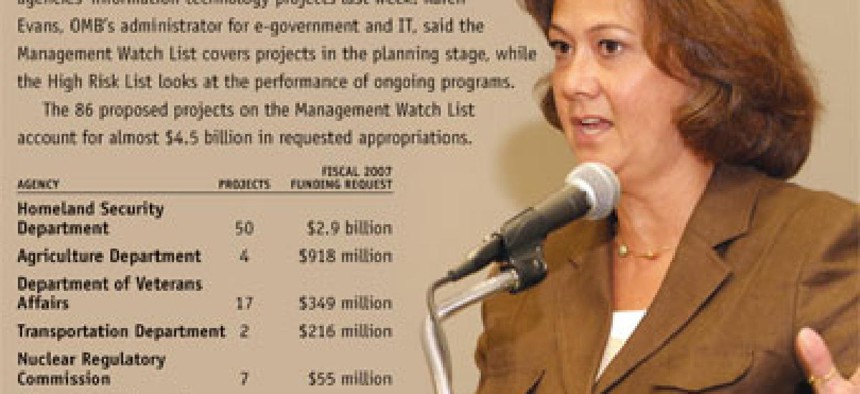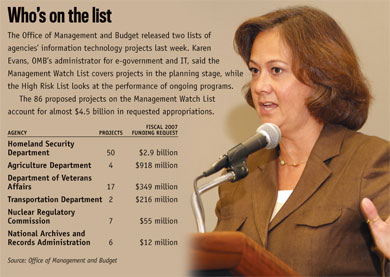OMB lifts the veil on IT worries

The agency has revealed two lists of projects that it says warrant expanded public oversight.
Last week, OMB posted online the Management Watch List and High Risk List, which OMB officials use to monitor the planning and performance of key projects. The Management Watch List includes projects for which agencies have submitted business cases with apparent weaknesses. The High Risk List identifies projects that need special attention from the agencies’ senior executives in the course of their execution.
The bigger projects on those lists often are of equal interest to oversight groups, such as congressional committees and the Government Accountability Office. The documents should help them do a better job of tracking the progress of big-ticket programs — and OMB’s oversight of them.
That is what GAO had in mind earlier this month when it recommended that OMB share the lists with Congress. With those documents in hand, Congress and GAO can collaborate with OMB in overseeing troubled projects, said David Powner, GAO’s director of IT management issues.
“It’s hard to stay on top of 900 projects,” Powner said.
Agencies could notice the difference, observers said.
Publicizing the two lists puts pressure on agencies to fix projects that are performing poorly because it puts them under the microscope, said Renee Courtland, a former OMB official and now a senior associate at Dutko Government Markets.
“Some large departments have a bad habit of thumbing their nose at criticism that originates from the management side of OMB,” she said. “If this report generates enough negative attention from congressional appropriators, even those agencies will sit up and pay attention.”
David McClure, former vice president of e-government at the Council for Excellence in Government and now a research director at Gartner, said congressional appropriators can use the lists to ask agencies more carefully honed questions.
However, the lists lack OMB’s project analyses, which would have provided more clarity about why a given project made the list, he said.
Under the Clinger-Cohen Act of 1996, agencies must submit business plans for IT investments to OMB. If an agency’s investment plan contains weaknesses, OMB puts it on the watch list and targets it for follow-up action.
Last year OMB had 263 investments on the watch list. Now there are 86, representing a savings of more than $5 billion, according to OMB.
Several experts said OMB has resisted sharing its Management Watch List because it is closely linked with budget formulation. OMB has been more willing to hand over its High Risk List.
In August 2005, OMB established its High Risk List for IT projects to ensure that agencies and programs were meeting their intended goals and producing results.
“If you are on the High Risk List, it does not mean that the project is at risk,” said Karen Evans, OMB’s administrator for e-government and IT, speaking Sept. 21 at a luncheon.
The designation merely means the projects need extra attention, which can be because of their costs or their importance, she said. She cited the transition to IPv6 as an example of a project that warrants placement on the list because of its importance.
In fiscal 2007, the federal government will spend about $64 billion on IT projects. Some observers are hopeful the lists will affect government spending priorities. “Any small step toward transparency can change the culture of spending in Washington,” said John Hart, spokesman for Sen. Tom Coburn (R-Okla.).
OMB’s decision to release the lists came a week after Congress sent a transparency bill to the White House. The bill would require OMB to build a searchable database of organizations that receive federal funding. The president expressed his support for the legislation and is expected to sign it into law this week.
NEXT STORY: Joseph Guerci named CTO for SAIC research group






